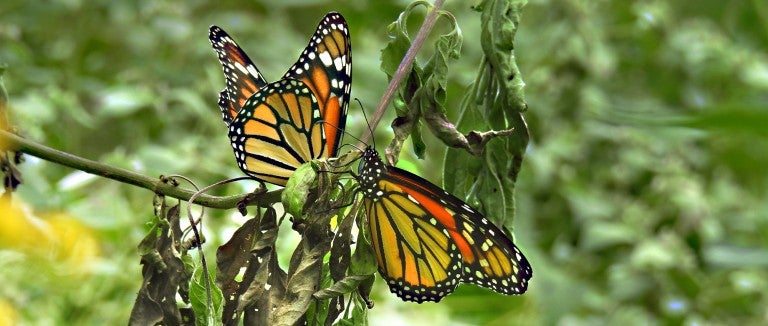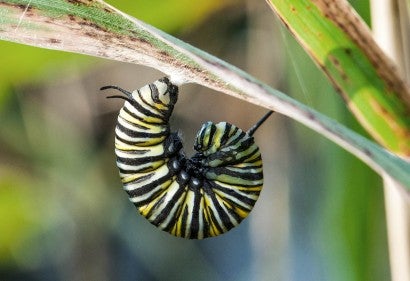If I hadn’t been watching with my own eyes, I might not have believed it myself. But here she was, a monarch butterfly, intently probing a dead plant in the middle of a vibrant patch of flowers she all but ignored.
Unaware of the scientific literature, she didn’t know that her kind wasn’t supposed to engage in such behavior. She hadn’t read the statements implying that monarchs are outliers among virtually all other milkweed butterfly species that extract chemical compounds from dried leaves for courtship and defense.
The first time I’d witnessed a male monarch probing leaves in my Maryland habitat, no one had told me any of this either. But the butterfly’s behavior didn’t match what I’d learned about monarchs’ life history: As caterpillars, they eat milkweed exclusively. While digesting the green leafy bits, they also sequester cardenolides, substances that provide lifelong defense. In adulthood, they imbibe only flower nectar. End of story—or so I’d thought.
A humane backyard is a natural habitat offering wildlife plenty of food, water and cover, plus a safe place to live free from pesticides, chemicals, free-roaming pets, inhumane practices and other threats. And it's so easy to build!

Describing the phenomenon in human terms, Boppré uses this analogy: Whereas the monarchs treat wildflowers and larval host plants as their “grocery stores,” they use PA-containing plants as their “drug stores.” Concealed inside cell walls, PAs are only detectable to monarchs when plants start to decay or are chewed on by other insects or otherwise injured. The butterflies regurgitate fluid onto the wilted leaf and ingest the slurry with their straw-like proboscises.
Though many other butterflies synthesize PAs into male courtship pheromones, male monarchs don’t seem to employ such romantic preambles. And given all the defenses they gain through milkweeds as larvae, the extra benefits of PAs to monarchs are not fully understood. But Boppré has a theory: that they might protect offspring from infection by a protozoan parasite that’s been spreading more intensively among monarch populations in recent years.
It’ll take many more observations, combined with controlled experiments, to untangle it all. Pharmacophagy is most likely common among monarchs in North America; it has occurred repeatedly and for long durations in my garden. But the relationship between PAs and monarchs has been neglected by Americans, Boppré says, and “we have no natural history observations from the United States”—except one in Florida in the 1970s and another in Missouri a decade ago.
Through Monarch Rx, we’ve already received reports from people in Michigan, Florida, Iowa and Indiana; such information can help determine what plants the butterflies use, which sex is attracted, under what weather conditions it happens and how often. As they migrate into the U.S. from Mexico in the coming weeks, I look forward to learning more from the monarchs, whose interactions with other organisms validate the core principles of humane gardening. Though many people claim that deer browsing inhibits butterfly gardening, my habitat is all the richer for welcoming all the animals; deer forage on some plants and leave an abundance of others for monarchs and everyone else. And while I’ve long nurtured fallen logs and leaves that feed and shelter so many creatures, the monarchs have shown me there’s even more life nurtured by decaying matter than I could have imagined—including on dead and broken wildflowers still standing, offering one last gift to the animals on their way back to the earth.
Be a scientist in your own backyard!
Want to learn more about your wild neighbors, contribute to the existing body of knowledge and have fun at the same time? Become a community scientist! Many professional researchers rely on data collected by amateurs to help identify trends, characterize behaviors and habitats, develop conservation plans and even identify new or threatened species. Whether you’re interested in migrating birds or spring blooms, flying squirrels or fireflies, frogs or fish, there’s a project for you. Get started at scistarter.org and citsci.org.
Want more content like this?
This was written and produced by the team behind All Animals, our award-winning magazine. Each issue is packed with inspiring stories about how we are changing the world for animals together.
Learn MoreSubscribe

